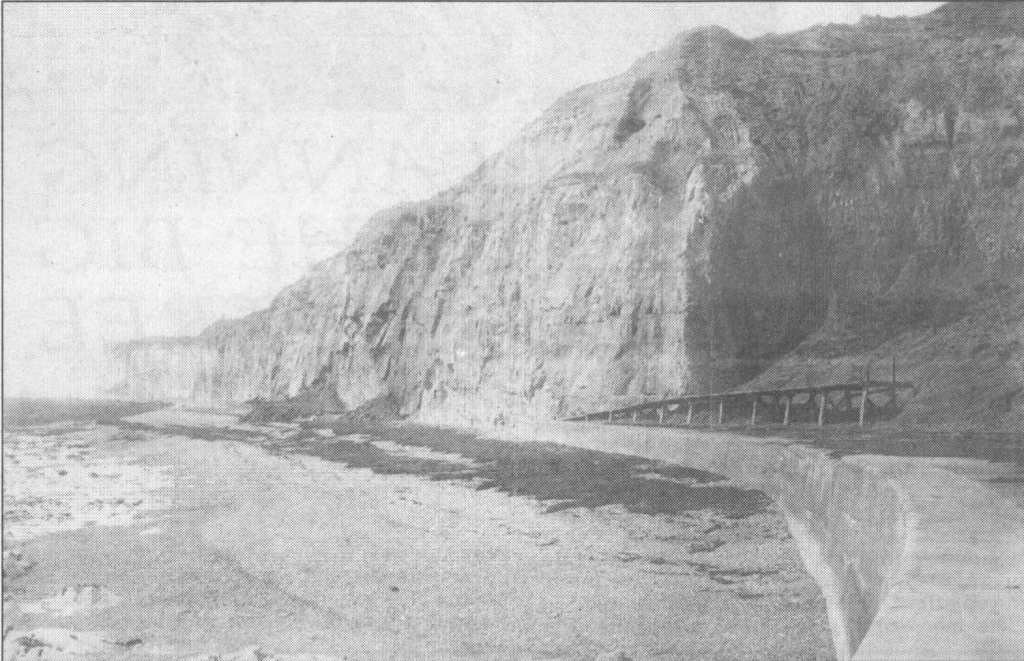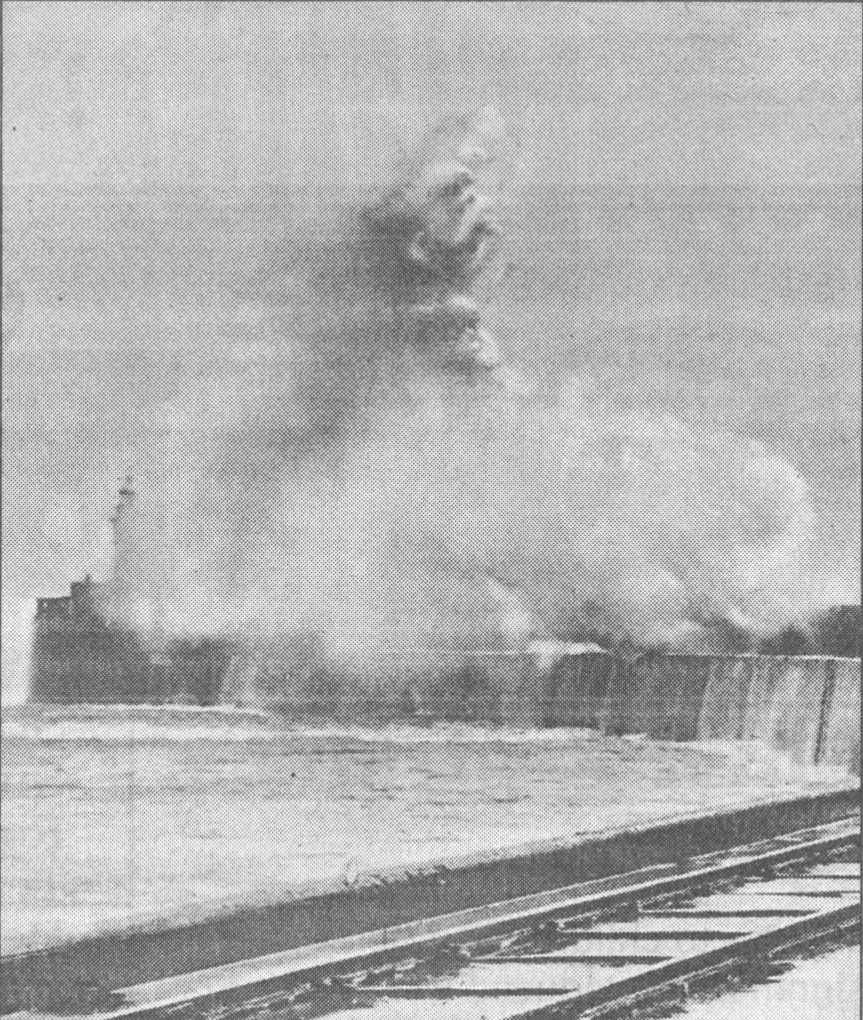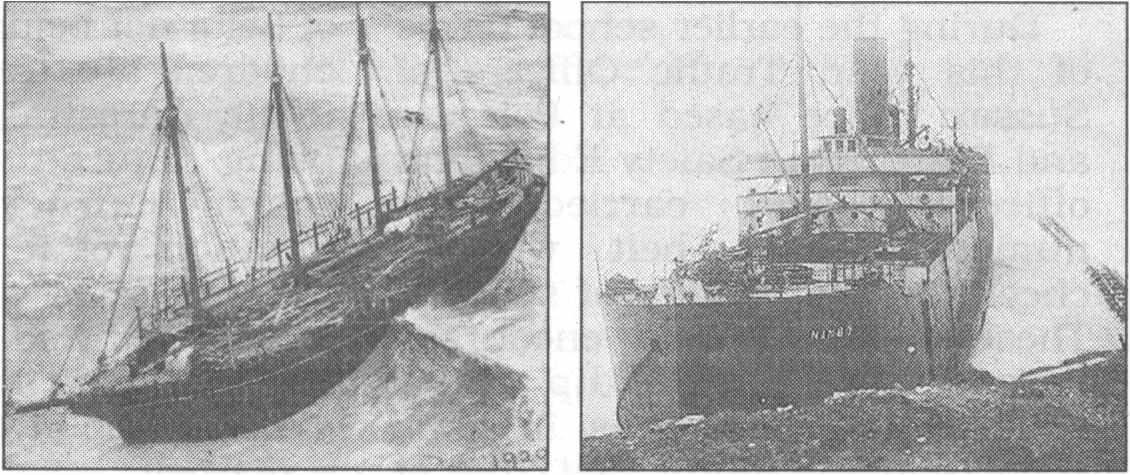

When man interferes - a beach appears!
Sussex Express 08-June-2001
 THE main picture in last week's article featured the massive crater on the west shingle beach resulting from the explosion there in 1944.
Two figures at the rim gave a good indication of the extent of this great hole, not just in the shingle but in the chalk below. No surprise that 180 tons of high explosive would make such an impression.
Another aspect of the whole affair which wouldn't be appreciated perhaps by our post-war population, is the fact to the best of my knowledge no other photos of the whole incident have ever appeared. You would not have been allowed to the foreshore, to the harbour and some of the streets close by
Security was most severe - if you wanted to be arrested just be seen with a camera. Some official war pictures were taken, of course, and most of those are quite well known.
Picture No. 1 shows our west beach in, I should think, the 1880s. The landward end of the breakwater has been there long enough to collect some shingle. Note how the concrete reaches up to the foot of the cliff, so much of the Fricker Rocks were exposed at this time.
Two falls have taken place from the upper strata, but before man interfered and caused this beach to gather, the sea would have reached at high water and washed the deposits away.
Of the timber ramp-like structure, I can only surmise that it was used in conjunction with horse-drawn tip trucks. They would have conveyed the cliff spoil from this area to be spread around the space between the sand beach wall and the Fort, so that the concrete of the promenade could be laid over it and the remainder left to become the still sparse grass area where now stands the cafe etc.
THE main picture in last week's article featured the massive crater on the west shingle beach resulting from the explosion there in 1944.
Two figures at the rim gave a good indication of the extent of this great hole, not just in the shingle but in the chalk below. No surprise that 180 tons of high explosive would make such an impression.
Another aspect of the whole affair which wouldn't be appreciated perhaps by our post-war population, is the fact to the best of my knowledge no other photos of the whole incident have ever appeared. You would not have been allowed to the foreshore, to the harbour and some of the streets close by
Security was most severe - if you wanted to be arrested just be seen with a camera. Some official war pictures were taken, of course, and most of those are quite well known.
Picture No. 1 shows our west beach in, I should think, the 1880s. The landward end of the breakwater has been there long enough to collect some shingle. Note how the concrete reaches up to the foot of the cliff, so much of the Fricker Rocks were exposed at this time.
Two falls have taken place from the upper strata, but before man interfered and caused this beach to gather, the sea would have reached at high water and washed the deposits away.
Of the timber ramp-like structure, I can only surmise that it was used in conjunction with horse-drawn tip trucks. They would have conveyed the cliff spoil from this area to be spread around the space between the sand beach wall and the Fort, so that the concrete of the promenade could be laid over it and the remainder left to become the still sparse grass area where now stands the cafe etc.Lifeboat heroes who did their duty to the end
Sussex Express 07-September2001
 SEPTEMBER is upon us and any time now severe gales can be expected around our coasts, a demanding time for the rescue services.
But perhaps it can be said that things are better these days because of the great advances in communications and the early warnings by radio of adverse weather conditions, giving potential victims the chance to seek shelter. Not so long ago things were very different!
Our first picture (right) illustrates well the effect such storms can have on an immovable object like the Newhaven Breakwater when such disturbances occur. This remarkable photograph was taken early in December 1929. Assuming the top of the lighthouse is 50 feet from its base at sea level, then that is a pretty big wave!
The upper part can just be seen at the left of one of the rounded metal housings for the searchlight. There was another on the west side. At the extreme left is a little hut which I presume was a shelter for the First World War crews who manned these lights, not that any such shelter could be of much benefit in the conditions portrayed here.
Of interest, too, is the rail track which came all the way from above the level crossing gates at the town station. This was purely for maintenance on the west side of the harbour. About where the wave touches the 'deck', here were points for a second length of rail to the end.
With this particular gale the service with Dieppe was cancelled for the while, a most uncommon happening. As I recollect there were three 'shouts' for the Lifeboat during the period of this storm, the most dramatic involving the four-masted Danish schooner Mogens Koch which was driven ashore at Cuckmere Haven on December?.
The vessel also carried a deck cargo of timber most of which had been washed away by this time. The Newhaven Lifeboat, the Sir Fitzroy Clayton, was of the open type with engine and sail. Her journey to rescue the distressed crew was bad enough, but her return caused much damage and injuries to crew and those rescued.
I remember her coming to Railway Quay where now the fast ferry berths. Dock workers and clerks cheered as she approached, a crane lowered a platform and the injured were placed on this and then lifted up to be taken away by ambulance.
Coxswain Dick Payne, regarded as one of 'the Greats' in lifeboat work, was one of the unfortunates and though he lived long enough to receive a silver goblet of thanks from the King of Denmark, as did all of the crew, his demise was not long afterwards. Signalman Ben Clark's goblet is on display at the museum.
Another victim of this time was the Italian Njmbo which foundered under the cliffs at Portobello after inflicting damage to the Brighton sewer outlet. With miles of coast to choose from she had to pick this spot. As I recollect, repairs or improvements had just been completed to the outfall. Must have a connection with a certain somebody's law, I feel.
Luckily, the Coast-guards were able to bring the stranded crew ashore by the use of Breeches Buoy from the cliff top. Our Lifeboat made the tortuous journey to 'be there'. The Morgens Koch was eventually refloated and brought into Newhaven and the Nimbo was towed away. A few more instances of interest about this period of sea drama - Lifeboat Coxswain Dick Payne and his crew had gone out in the evening of December 6,1929 to the small steam freighter Merwede of Rotterdam which had been driven ashore near Tidemills.
Her cargo was of house bricks for Newhaven to be transported in time to Pence-haven for the building of the new 'city by the sea'!
Nurses from the Beach Hospital assisted the Coastguard in hauling in the rescued by Breeches Buoy. The men were dried, thawed, given fresh clothes and fed by the kindness of their hosts.
I remember seeing the mast light of the Merwede swaying to and fro as she wallowed near the shore. Her cargo was later unloaded on to the beach and when the sea was calm and the tide right, a tug with what seemed a mile-long tow rope, hauled her off into deep water.
So, on the next morning came the drama of the Morgens Koch at Cuckmere. No respite there. Not only did Cox Payne get a silver goblet, but also an inscribed gold hunter watch, the RNLI Silver Medal -and a Treasury note!
Ben Clark was to lose his hfe on duty during the last war in the blackout. The next Lifeboat, the Cecil & Lillian Philpott which had gone out to the assistance of a Naval trawler in distress off Seaford, was rammed by the craft it had gone to help. Incredible damage was done, but she remained afloat and got home. Sadly, Ben Clark had been knocked overboard and drowned.
Finally to the Nimbo. The damage she caused to the Portobeilo outfall cost £12,760 to repair, a lot in those days. Her visit was on either the 11th or 13th of November, 1929.
The Captain presented Cox Payne with a kitten born aboard the 3,870 ton steamer some time before the disaster. Fludes Carpets on Denton Island is on the site of Sefton Terrace where a black kitten called Nimbe grew up - if you get any vibes, seek help!
SEPTEMBER is upon us and any time now severe gales can be expected around our coasts, a demanding time for the rescue services.
But perhaps it can be said that things are better these days because of the great advances in communications and the early warnings by radio of adverse weather conditions, giving potential victims the chance to seek shelter. Not so long ago things were very different!
Our first picture (right) illustrates well the effect such storms can have on an immovable object like the Newhaven Breakwater when such disturbances occur. This remarkable photograph was taken early in December 1929. Assuming the top of the lighthouse is 50 feet from its base at sea level, then that is a pretty big wave!
The upper part can just be seen at the left of one of the rounded metal housings for the searchlight. There was another on the west side. At the extreme left is a little hut which I presume was a shelter for the First World War crews who manned these lights, not that any such shelter could be of much benefit in the conditions portrayed here.
Of interest, too, is the rail track which came all the way from above the level crossing gates at the town station. This was purely for maintenance on the west side of the harbour. About where the wave touches the 'deck', here were points for a second length of rail to the end.
With this particular gale the service with Dieppe was cancelled for the while, a most uncommon happening. As I recollect there were three 'shouts' for the Lifeboat during the period of this storm, the most dramatic involving the four-masted Danish schooner Mogens Koch which was driven ashore at Cuckmere Haven on December?.
The vessel also carried a deck cargo of timber most of which had been washed away by this time. The Newhaven Lifeboat, the Sir Fitzroy Clayton, was of the open type with engine and sail. Her journey to rescue the distressed crew was bad enough, but her return caused much damage and injuries to crew and those rescued.
I remember her coming to Railway Quay where now the fast ferry berths. Dock workers and clerks cheered as she approached, a crane lowered a platform and the injured were placed on this and then lifted up to be taken away by ambulance.
Coxswain Dick Payne, regarded as one of 'the Greats' in lifeboat work, was one of the unfortunates and though he lived long enough to receive a silver goblet of thanks from the King of Denmark, as did all of the crew, his demise was not long afterwards. Signalman Ben Clark's goblet is on display at the museum.
Another victim of this time was the Italian Njmbo which foundered under the cliffs at Portobello after inflicting damage to the Brighton sewer outlet. With miles of coast to choose from she had to pick this spot. As I recollect, repairs or improvements had just been completed to the outfall. Must have a connection with a certain somebody's law, I feel.
Luckily, the Coast-guards were able to bring the stranded crew ashore by the use of Breeches Buoy from the cliff top. Our Lifeboat made the tortuous journey to 'be there'. The Morgens Koch was eventually refloated and brought into Newhaven and the Nimbo was towed away. A few more instances of interest about this period of sea drama - Lifeboat Coxswain Dick Payne and his crew had gone out in the evening of December 6,1929 to the small steam freighter Merwede of Rotterdam which had been driven ashore near Tidemills.
Her cargo was of house bricks for Newhaven to be transported in time to Pence-haven for the building of the new 'city by the sea'!
Nurses from the Beach Hospital assisted the Coastguard in hauling in the rescued by Breeches Buoy. The men were dried, thawed, given fresh clothes and fed by the kindness of their hosts.
I remember seeing the mast light of the Merwede swaying to and fro as she wallowed near the shore. Her cargo was later unloaded on to the beach and when the sea was calm and the tide right, a tug with what seemed a mile-long tow rope, hauled her off into deep water.
So, on the next morning came the drama of the Morgens Koch at Cuckmere. No respite there. Not only did Cox Payne get a silver goblet, but also an inscribed gold hunter watch, the RNLI Silver Medal -and a Treasury note!
Ben Clark was to lose his hfe on duty during the last war in the blackout. The next Lifeboat, the Cecil & Lillian Philpott which had gone out to the assistance of a Naval trawler in distress off Seaford, was rammed by the craft it had gone to help. Incredible damage was done, but she remained afloat and got home. Sadly, Ben Clark had been knocked overboard and drowned.
Finally to the Nimbo. The damage she caused to the Portobeilo outfall cost £12,760 to repair, a lot in those days. Her visit was on either the 11th or 13th of November, 1929.
The Captain presented Cox Payne with a kitten born aboard the 3,870 ton steamer some time before the disaster. Fludes Carpets on Denton Island is on the site of Sefton Terrace where a black kitten called Nimbe grew up - if you get any vibes, seek help!
Trouble at the mills? Weighing up the delicate implications of plans to extract rich gravel deposits from a coastal wildlife haven
Sussex Express, 30-01-1987
by JUDY MOORE